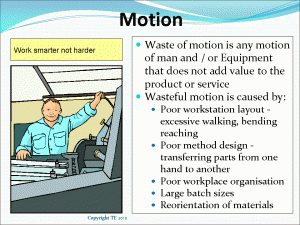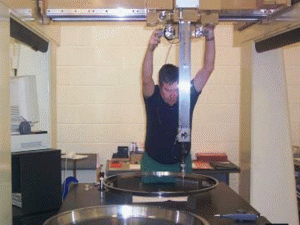The waste of motion
Motion is one of the seven wastes of lean manufacturing or the 7 mudas. Waste being a process step that is not value adding, moving is not necessarily working! If you have read the page regarding value add and non value add then you will understand that only a process step that transforms the product in some manner that the customer explicitly wants is a value adding step, moving product does not transform it any way therefore is a waste.
Motion as a waste has a long history, being highlighted by Frank Gilbreth within his “motion studies” at the start of the twentieth century; he observed bricklayers bending to lift heavy bricks from floor level and showed that delivering the bricks to the workers at the level they were required made a huge increase in the working efficiency as well as reducing strain induced injuries.
Whilst we may not be able to eliminate all motion within a work cell we can work to minimize it and make each movement as stress free as possible.
Symptoms of the waste of motion;
The waste of motion in your process gives rise to a number of problems that are either immediately obvious or hidden beneath the surface waiting to rise up and bite you in the future. The first and most obvious is a lowering of your work efficiency, if your workers are spending their times lifting, retrieving, and searching rather than actually assembling then your work efficiency will be very low.
A less obvious problem potentially is the harm that unnecessary motion can cause in the long term, constantly lifting items (even those that are not excessively heavy) from a pallet at floor level can cause muscle and back strains that can lead to sickness and absenteeism in your workforce. Even a machine that has to move excessive distances within its cycle will be subjected to additional wear in bearings and joints leading to premature breakdowns.
Causes of the Waste of Motion.
The main causes of the waste of motion are with regards to cell layout, placing product at floor level on pallets, poorly arranged space, tools that are disorganized, lack of space and organization for component parts and so on.
Another problem can be the design of your working method, does it cause you to constantly turn and rearrange the product being worked on? Design of the product itself can impact in the same manner.
Examples of wastes of motion
- A machine that travels excessive distance from start point to where it begins work.
- Heavy objects placed on low or high shelves.
- Searching for tools and equipment.
- Walking across work space to retrieve components or use machines.
- Constantly turning and moving product during assembly.
- Having to reorient component when taken from its location.
- Reaching excessive distances when taking components and tools.
How to eliminate or reduce the waste of Motion
Whilst there will always be some form of motion within your process it should be minimized as much as possible, both to reduce overburden (Muri) and to improve your efficiencies; this is a benefit to you and your employees as you are making their work easier.
The simplest and most powerful lean manufacturing tool at your disposal to eliminate the waste of motion within your work cells is that of 5S; 5S challenges your team to review each and every step of their operation and eliminate the symptoms of the seven wastes. These changes will on the whole cost you nothing other than the time of your team but will result in efficiency gains in the order of 10% to 30% in most cases as well as making your work area safer preventing accidents (and the law suit that follows.)
5S also starts the ball rolling with regard to standardized operations, it should lead you to develop standard operating procedures (SOP) for your processes defining the best way to conduct a specific operation.
The lean tool of single minute exchange of Die (SMED) will also remove many wasteful motions from your setup process, using similar principles to 5S, they are applied to the setup process of your work and will often reduce setups from hours to single minutes.
Motion is a significant factor within the seven wastes and every effort should be made to remove it from your processes to both increase efficiencies as well as make work easier for all those involved. Movement is not work, but it costs you time and money; so look to lean tools such as 5S to help you reduce and eliminate excessive motion from your processes.
Reduce Costs and Improve Profits by preventing Waste.
By eliminating motion as one of the seven wastes in your processes you reduce the number of non value adding steps and improve your efficiencies as well as making your process more ergonomic and thus safer for your employees. By going through a process of implementing the principles of lean manufacturing you will eliminate or reduce the effects of the seven wastes and thus reduce the costs associated with them. Every penny saved in reducing the seven wastes is a penny directly back onto your profit, so get to work reducing the waste of waiting and the other wastes of lean manufacturing;
The waste of inventory; all of your raw materials, work in progress and the finished stock that you hold.
The waste of waiting; waiting for work to arrive, cycles to finish, information or to be told what to do.
The waste of Transport; the movement of product from one location to another.
The waste of Overproduction; producing more than is required or before it is required.
The waste of Overprocessing; adding more value than the customer had specifically asked for or expects.
The waste of Defects; Product or service that does not meet your customer’s requirements.
The waste of Resources; Not conserving your electricity, gas, water and any other resources.
The waste of creativity; Not involving your employees in your business.



this was very helpful!!!!
5S and SMED for a certain station to reduce motion. But what we should use for motion waste in the macro level, like the factory layout prospective? Thank you very much!
Excellent Article. Total clarity on waste of Motion.